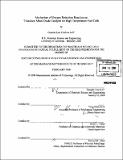Mechanism of oxygen reduction reaction on transition metal oxide catalysts for high temperature fuel cells
Author(s)
La O', Gerardo Jose Cordova
DownloadFull printable version (38.94Mb)
Other Contributors
Massachusetts Institute of Technology. Dept. of Materials Science and Engineering.
Advisor
Yang Shao-Horn and Harry L. Tuller.
Terms of use
Metadata
Show full item recordAbstract
The solid oxide fuel cell (SOFC) with its high energy conversion efficiency, low emissions, silent operation and its ability to utilize commercial fuels has the potential to create a large impact on the energy landscape. Although SOFCs do not require noble metal catalysts, it has the disadvantage of having to operate at elevated temperatures (>800°C) due to the poor catalytic activity of the oxygen reducing cathode. This thesis research is focused on identifying the fundamental reaction mechanisms and pathways for oxygen reduction reaction (ORR) in transition metal oxide cathodes to enable lower operating temperature and improve device performance. The approach used here involves dense and thin-film microelectrodes of Lao.sSr0.2M03-d (M = Mn and Fe) supported on thin film 8YSZ electrolyte that was fabricated via microfabrication/photolithography techniques. These microelectrodes were then probed mainly via electrochemical impedance spectroscopy (EIS) under varying temperature, oxygen partial pressure, microelectrode size/thickness, and applied polarization potential to determine the rate-limiting step(s) during ORR. For La0.8Sr0.2MnO3-d (LSM), at least four reaction or transport process have been identified from EIS; (i) ion conduction in 8YSZ, (ii) possible surface diffusion on LSM, (iii) surface exchange reaction on LSM and (iv) TPB/bulk charge transfer on LSM. The rate-limiting step and the relative contribution of ORR current from the bulk and three-phase boundary pathways were found to vary with temperature. This was quantified by correlating microelectrode geometry to the impedance. For Lao.sSr0.2FeO3-d (LSF), overall impedance was found to be at least one to two of magnitude smaller than LSM. (cont.) Three reactions or transport processes were observed that were attributed to (i) ion conduction in 8YSZ, (ii) possible surface diffusion on LSF and (iii) oxygen surface exchange reaction on LSF. The bulk pathway was found to be dominating down to 570°C and surface exchange as the rate-limiting step. Studies to probe the surface reaction mechanisms showed that oxygen exchange coefficients (kchem) were highly dependent on material electronic properties rather than oxygen vacancy contents. Using polarization potentials, kchem was found to be increased by up to 1 order of magnitude due variations in lanthanum elemental contents on the microelectrode surface. Design principles for thin-film based cathodes are proposed to enhance performance of SOFCs operating at <700°C. For dense and thin-film electrodes, enhancement of surface exchange rates via physical or chemical modifications is critical to enhancing surface catalytic activity. Use of internal microstructure with large grain boundary fractions to improve bulk oxygen transport is important, especially in LSM, for reducing ion transport losses.
Description
Thesis (Ph. D.)--Massachusetts Institute of Technology, Dept. of Materials Science and Engineering, 2008. Includes bibliographical references (p. 157-162).
Date issued
2008Department
Massachusetts Institute of Technology. Department of Materials Science and EngineeringPublisher
Massachusetts Institute of Technology
Keywords
Materials Science and Engineering.